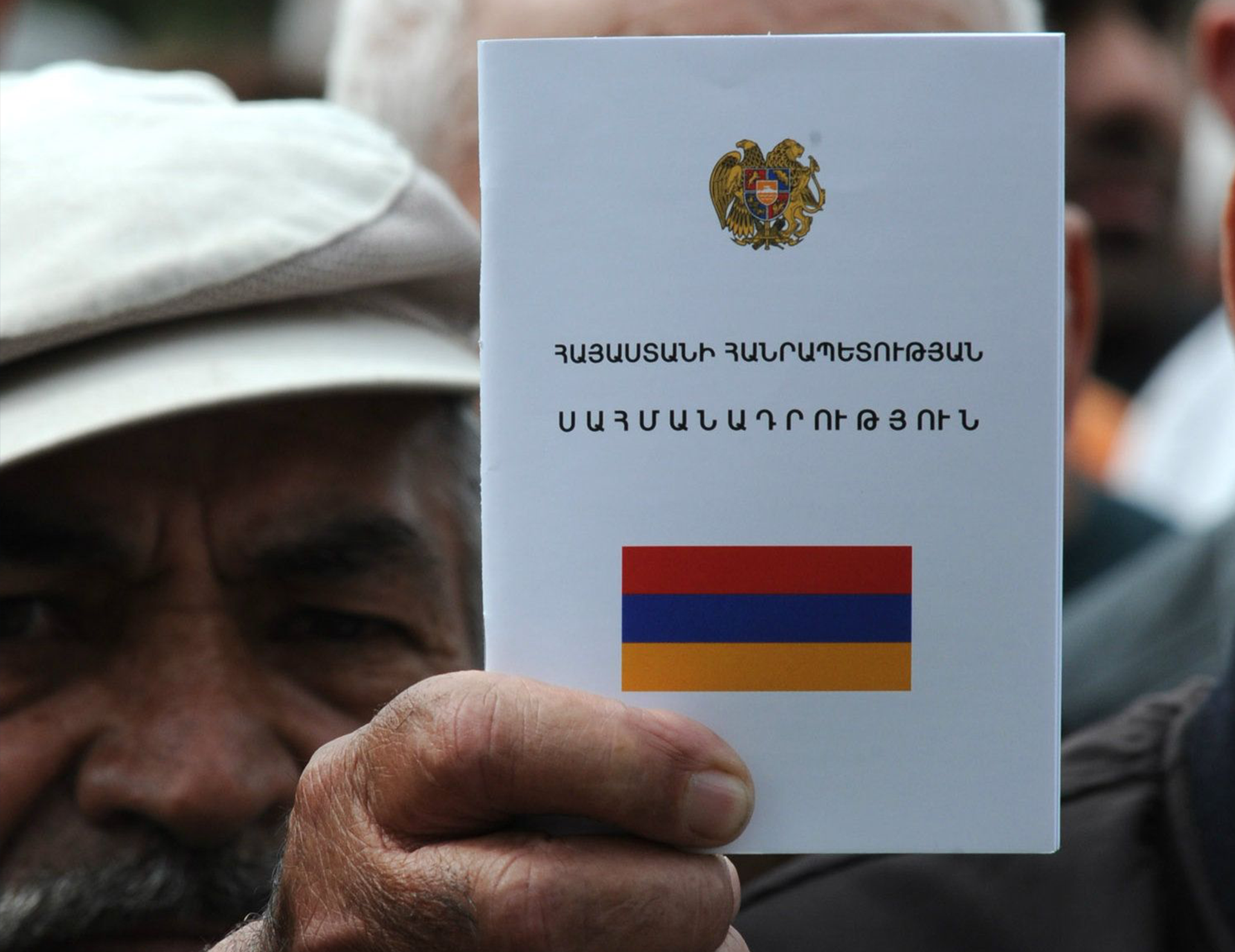Armenia’s Constitutional Court Dismantles One Barrier to Peace with Azerbaijan, While Erecting Others

Introduction
In a move that has left many in Armenia, Azerbaijan, and beyond scratching their heads, the Armenian Constitutional Court adopted on September 26 a landmark ruling No. 1749, greenlighting the border delimitation process with Azerbaijan.
The text of the ruling (henceforth referred to as Ruling 1749 or simply, the ruling) was published three days later over the weekend, which invites questions about whether this delay was intended to minimize scrutiny as the initial news cycle on the decision faded and public attention shifted elsewhere.
Some Armenian commentators hailed the ruling, claiming it invalidates Baku's criticism that Armenia's Constitution harbors territorial claims against Azerbaijan. On October 4, Armenian foreign ministry spokesperson Ani Badalyan echoed this argument, claiming the ruling proves Armenia’s Constitution contains no territorial claims. Others, mostly from the opposition, criticized the decision, arguing that the Court acted upon the political instruction of the Pashinyan government.
In Azerbaijan, the initial reaction to the decision was similarly not uniform, although a shared sentiment was that of skepticism. A predominant view was that the ruling maintains legal ambiguities and will have no effect on Baku’s demand from Yerevan to change its Constitution in order to resolve the question of constitutionally enshrined territorial claims against Azerbaijan. Some analysts tried to approach the ruling in a more positive light, arguing that the Court's decision was effectively a legal acknowledgement that Karabakh is not part of Armenia. The first official reaction from Baku came on 4 October, when, the Azerbaijani MFA spokesperson Aykhan Hajizade, responding to his Armenian counterpart’s earlier remarks, similarly expressed skepticism, emphasizing that the ruling does not address Baku's concerns about Armenia's constitutionally enshrined territorial claims.
It should be noted that, at the time of writing, the text of the Court's decision was publicly available only in Armenian. Given the language barriers and lack of comprehensive fact-based analysis, there is a pressing need to better understand this landmark ruling and its ramifications.
This article provides a comprehensive analysis of Ruling 1749 and its ramifications for the future of the Armenian-Azerbaijani peace process. AI-assisted translation of the Court`s ruling was used to facilitate this analysis. When translating key sections of the text, output from multiple platforms were utilized and compared to ensure maximum accuracy and minimize potential misinterpretation of critical parts. Despite a high degree of confidence in the accuracy of the English translation on which this analysis is based, minor inaccuracies may still occur when quoting excerpts verbatim.
Ruling 1749: The unraveling of the “conspiracy of silence”
In its ruling, the Court has decided that the regulation governing joint activities of Armenian and Azerbaijani delimitation commissions complies with Armenia's Constitution. This regulation was agreed upon by the sides in August 2024 and was marked as the first bilateral legal document to be signed by Armenia and Azerbaijan since both countries regained their independence. As such, the Court's decision to approve the regulation is a positive development that enables the Pashinyan government to proceed further with bilateral delimitation activities with Azerbaijan.
…the Court's ruling is notable not for its operative (decision) part, but unprecedented legal reasoning, which upon a close look, suggests that the Court may have erected more barriers to long-term peace than it has dismantled.
However, the Court's ruling is notable not for its operative (decision) part, but for its unprecedented legal reasoning, which upon closer examination, suggests that the Court may have erected more barriers to long-term peace than it has dismantled.
The ruling, which spans 33 pages, is almost entirely dedicated to discussing the preamble of the Constitution and its connection to the 1990 Declaration of Independence. The choice of this angle is not coincidental given that Azerbaijan's main demand from Armenia has been the removal of controversial references in its Constitution's preamble that are interpreted as territorial claims.
The Court acknowledges that since Armenia’s independence, there has been “the absence of a doctrinal position from the Constitutional Court regarding the possible influence of the [1990 Independence] Declaration on the content of the Constitution” (2. para 2). Consequently, the Court states, this ruling is the first one to address “the normative relationship between the Declaration and the provisions of the Constitution” (3.5). This is a remarkable admission that in over three decades of independent statehood, Armenia’s political-legal framework has lacked a clear interpretation of how the principles enshrined in the 1990 Independence Declaration relate to and influence the Constitution. Far from being an oversight, this ambiguity has been a strategic choice and part of what I previously referred to as “a conspiracy of silence”, whereby Armenian officials, analysts, and media have intentionally evaded public discussions on the territorial claims against Azerbaijan enshrined in their constitutional-legal system.
The principle of “immutability”: a constitutional coup of sorts by the Court
One of the key parts in the Court’s legal analysis is its interpretation of the “immutable” provisions of Armenia’s Constitution. Referring to its little-known decision No. 1590 dated 29 April 2021, the Court reiterated that the Preamble, Articles 1, 2, 3 and 203 of the Constitution are “immutable”, i.e. they are so fundamental that they cannot be changed under any circumstances, not even by popular referendum. To be clear, the Article 203 proclaims that only “Articles 1, 2, 3 and 203 of the Constitution shall not be subject to amendment.” It does not contain any direct or indirect reference to the preamble. Yet, Armenia’s Constitutional Court single-handedly expanded the legal effect of the “immutability” clause to the preamble, thereby setting a major precedent for future legislative processes.
It is noteworthy that the Court’s April 2021 decision made virtually no headlines at the time. All major media outlets in both Armenia (at least its Russian and English-language segment) and Azerbaijan overlooked this decision. It appears that the proponents of this decision succeeded in obscuring its importance by framing it within a relatively mundane issue concerning the Armenian parliament’s internal procedures for passing constitutional amendments.
…by ruling that the principle of immutability applies to the preamble, the Constitutional Court essentially carried out a constitutional coup. It denied the Armenian people and their elected representatives the opportunity to amend the only aspect of Armenia’s Constitution that Azerbaijan objects to.
Yet, by ruling that the principle of immutability applies to the preamble, the Constitutional Court essentially carried out a constitutional coup. It denied the Armenian people and their elected representatives the opportunity to amend the only aspect of Armenia’s Constitution that Azerbaijan objects to. As long as this legal decision stands, even if Armenia adopts a completely new constitution – which Pashinyan hopes to achieve by 2027 – the preamble would remain unchanged, effectively nullifying any hopes of resolving the disagreement on this core issue through constitutional reforms.
An injection of legal ambiguity as an escape tactic
Having reiterated the “immutability” of the preamble, the Court proceeds to analyze the “discrepancies” between the Constitution and the Declaration of Independence. It is notable that this is the first time that the Armenian Constitutional Court refers to “discrepancies” per se between these two foundational documents.
The Court’s legal analysis unavoidably touches upon the 1989 declaration “on the reunification of the Armenian SSR and Nagorno-Karabakh”, an issue carefully evaded by Armenia’s legal system up to now. This fateful declaration, dubbed the “miatsum” (Armenian for “unification”) declaration was incorporated into the 1990 Declaration of Independence, which subsequently made its way to the preamble of Armenia’s Constitution “as a basis [for] the fundamental principles of the Armenian Statehood and the national objectives”. This formulation is at the core of the Azerbaijani concerns over Armenia’s constitutionally enshrined territorial claims.
In addressing this key issue, the Court adopts what it terms a “‘narrow’ interpretation” of the national objectives enshrined in the Constitution, arguing that not all objectives listed in the Declaration of Independence have been incorporated into the Constitution. Specifically, the Court states, the 1989 “miatsum” declaration cannot be construed as part of the constitution due to the absence of explicit reference to it in the Constitution’s text.
Yet, this interpretation contradicts both Armenia’s and the Court’s own past practices. In 1998 and 2003, the Constitutional Court certified Robert Kocharyan’s election as the president of Armenia, despite the fact that the Armenian Constitution at the time required presidential candidates to have resided in Armenia for 10 years prior to the election and to have been citizens of Armenia during that period. Kocharyan, a native of Karabakh, moved to Armenia in 1997, thus failing to meet either criterion. Despite the opposition contesting his eligibility, Kocharyan’s supporters justified his candidacy by referring to the legal validity of the 1989 declaration in Armenian legislation.
Another important precedent that reveals inconsistencies and casts shadow over the legal rationale used by the Court is its 2010 decision regarding the Armenia-Türkiye protocols. In that decision, the Court introduced legal caveats on the recognition of borders between Armenia and Türkiye, rendering the protocols practically meaningless. At the time, the Turkish foreign ministry accused Armenia of undermining “the very reason for negotiating these Protocols”.
Thus, in its 2010 decision, the Court ruled that the provisions of the protocols “cannot be interpreted or applied... in a way that would contradict the provisions of the Preamble to the [Armenian] Constitution and [my emphasis] the requirements of Paragraph 11 of the Declaration of Independence of Armenia.” Here, the reference to the Paragraph 11 (which lists a genocide recognition in “Western Armenia” among Armenia’s “national objectives”) is even more telling, because the Court had essentially adopted an “expansive” interpretation of the “normative relationship” between the Independence Declaration and the provisions of the Constitution by essentially ordering that all international treaties signed by Armenia should conform to the “national objectives” listed in the Declaration of Independence.
Anticipating criticism of this apparent inconsistency, the Court attempted to reconcile its past “expansive” interpretations of constitutionally enshrined “national objectives” with its current “narrow” interpretation.
Anticipating criticism of this apparent inconsistency, the Court attempted to reconcile its past “expansive” interpretations of constitutionally enshrined “national objectives” with its current “narrow” interpretation. In doing so, the Court based its argument entirely on a technical detail: it asserted that the preamble of the Constitution and Paragraph 11 of the Declaration of Independence are to be regarded as separate concepts, connected in the 2010 decision by the conjunction “and”. This means, according to the Court, that each concept has its own legal weight, rather than being viewed as one. Thus, the Court concludes in an apparently defensive maneuver, its 2010 decision “has no doctrinal inconsistency with [the current] decision of the Court” (3.4.1.).
Given the persistent inconsistencies in both the political actions of the Armenian State and its Constitutional Court’s practice, the reliance on a mere conjunction (“and”) to support an argument regarding the absence of “doctrinal inconsistency” between the Court’s past and present rulings hardly appears convincing, leaving more questions than answers.
Lastly, having decided that the 1989 “miatsum” declaration does not form a part of the Constitution, the Court abruptly concludes that it is not required to further assess the implications of this declaration for the issues at hand in this case (3.7). Thus, the Court essentially exercises a strategic evasion maneuver, designed to circumvent the deeply contentious implications of this declaration in Armenia’s constitutional-legal system.
Conclusion: time for clarity
Speaking in August 2023, Pashinyan famously said that Armenia’s Declaration of Independence created a “confrontational narrative...that kept [Armenia] in constant conflict with [its] neighbors.” In January 2024, he went further by specifically referring to the 1989 “miatsum” declaration and proclaiming that maintaining a reference to this declaration in the Constitution “means that we'll never have peace.” The recent decision of the Constitutional Court is a missed opportunity, since it did nothing to alleviate the dilemmas faced by the Armenian people that Pashinyan himself admitted in the recent past.
Despite its approval of the border delimitation process, Ruling 1749 overall constitutes a step backward for the Armenian-Azerbaijani peace process. The Court’s extension of the principle of immutability to Constitution’s preamble raises questions about the Court’s legal overreach and undermines Armenia’s democratic governance and future constitutional reforms. By elevating the text of the preamble above the will of the people, selectively reinterpreting past rulings, and completely avoiding a legal appraisal of the 1989 “miatsum” declaration, the Court has effectively tried to further obfuscate rather than clarify the issue of Armenia’s constitutionally enshrined territorial claims against Azerbaijan.
Despite claiming immutability for the preamble, the ruling vividly illustrates the urgent need for re-evaluation and reform of Armenia's constitutional-legal framework to enable meaningful normalization with Azerbaijan.
…the reform of Armenia’s constitutional-legal framework should begin not with changes to the Constitution itself, but with the formal rescinding of the 1989 “miatsum” declaration.
As the author has argued before, the reform of Armenia’s constitutional-legal framework should begin not with changes to the Constitution itself, but with the formal rescinding of the 1989 “miatsum” declaration. This declaration serves as the legal foundation and primary source of Armenia’s territorial claims against Azerbaijan. Rescinding it would bring a much-needed legal and political clarity to the core issue of unambiguous recognition of territorial integrity and, in doing so, significantly reduce the controversy – both for Armenian and Azerbaijani public opinion – surrounding future constitutional reforms in Armenia. Pashinyan’s ruling “Civil Contract” party holds majority in parliament. If the Armenian government demonstrates a genuine effort, rescinding the “miatsum” declaration through a simple majority vote in parliament would be a guaranteed outcome. This would represent a “small effort, big gain” move for Armenia, if it genuinely seeks to pursue stable and sustainable peace with Azerbaijan.







